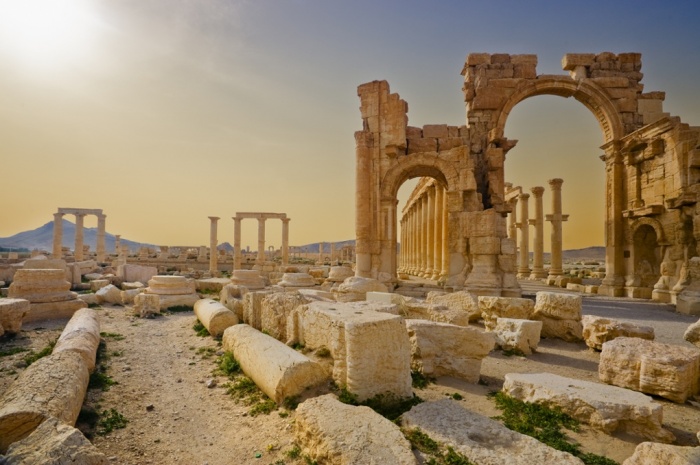Daesh Detonates Palmyra Heritage, This Time With Humans
Palmyra

NEW DELHI: The Islamic State (also known as Daesh) tied three people to pillars in the ancient section of Palmyra and killed them by detonating the pillars, the Syrian Observatory for Human Rights reported.
The Syrian Observatory for Human Rights, a UK-based organisation, said that it learned of the executions from local sources. Rami Abdel Rahman, head of the organisation, said that Daesh "tied three individuals it had arrested from Palmyra and its outskirts to the columns... and executed them by blowing up" three columns.
"There was no one there to see (the execution). The columns were destroyed and IS has prevented anyone from heading to the site," Khaled al-Homsi, an activist from Palmyra told AFP adding that Daesh had yet to inform local residents who the executed individuals were or why they had been killed.
Mohammad al-Ayed, also an activist from Palmyra, said the columns were "archeological, and there are many like them still present in Palmyra."
"IS is doing this for the media attention, so that IS can say that it is the most villainous, and so it can get people's attention," al-Ayed told AFP.
The executions follow a wave of explosions and destruction caused to ancient structures in Palmyra. Earlier this month, the militants blew up the Arch of Triumph in Palmyra.
The Arch was built 2000 years ago, in the ancient Roman city that UNESCO has described as one of the most important cultural centres of the ancient world.
Last month, the militant group blew up three funerary towers in Palmyra. These included the Tower of Elhabel, which was built in AD103 and was well preserved.
Before that, the militants blew up two 2000 year old temples in Palmyra. Satellite images have since confirmed that the main temple in the Palmyra, the Temple of Bel, dating to the 1st century AD, has been destroyed. The temple of Bel is the second temple to have been destroyed in the ancient city since Daesh captured it, with the militant group also destroying the ancient temple of Baalshamin, also dating to the first century AD.
This is not the first time that the militant group has destroyed culturally important structures. In January this year, the Islamic State ransacked the central library in the Iraqi city of Mosul, burning thousands of books. In February, a video emerged showing the destruction of ancient artefacts in Mosul’s central museum. In March, the militants used explosives and bulldozers on Nimrud, one of Iraq's greatest archaeological treasures. Also in March, ruins in Hatra were destroyed.
Palmyra was captured in May this year, and many worry that the UNESCO world heritage city will suffer a terrible fate. An indication of this was provided last month, when pictures emerged of militants destroying artefacts looted from the ancient ruins of Palmyra. The pictures showed six statues being hit with sledgehammers whilst a crowd looked on. At the same time, Syria's antiquities director Maamoun Abdelkarim said that Daesh group had destroyed a 2000-year-old statue of a lion from the Palmyra ruins.
The group also published photos of what they said was the destruction of two Islamic shrines near Palmyra, which they called "manifestations of polytheism.”
Since then, Abdulkarim has said that Palmyra “is doomed.” UNESCO has called such acts war crimes and says Daesh plans to wipe out evidence of Syria's diverse heritage.
In fact, the group recently executed the city’s antiquities chief, Khaled Asaad, who spent more than 50 years of his life safeguarding Palmyra’s heritage, linking the execution to a so-called objection of polytheism, with a sign attached to the pictures being circulated online stating that Asaad was executed for overseeing “idols” in Palmyra, attending “infidel” conferences and for staying in touch with his brother and palace officials even after IS took over.
In addition to threatening Palmyra’s cultural heritage, the militant group have killed over 200 people, including civilians, in and around Palmyra since May.
Here is a look at the cultural richness of Palmyra which stands threatened.
Temple of Baal-Shamin, Palmyra
Dedicated in 131, the temple of Baalshamin has been called Palmyra's "most significant surviving temple other than that of Bel". Baalshamin or Ba'al Šamem[2] (Aramaic: ??? ????), lit. 'Lord of Heaven(s)', is a Northwest Semitic god and a title applied to different gods at different places or times in ancient Middle Eastern inscriptions, especially in Canaan/Phoenicia and Syria. The title was most often applied to Hadad, who is also often titled just Ba‘al. Baalshamin was one of the two supreme gods and the sky god of pre-Islamic Palmyra in ancient Syria. (Bel was the other supreme god.) There his attributes were the eagle and the lightning bolt, and he perhaps formed a triad with the lunar god Aglibol and the sun god Malakbel.
Gate of the fortified Temple of Bel
Center of Bel
The Temple of Baal (Arabic: ???? ??) is an ancient stone ruin located in Palmyra, Syria. The temple, consecrated to the Semitic godBaal, worshipped at Palmyra in triad with the lunar god Aglibol and the sun god Yarhibol, formed the center of religious life in Palmyraand was dedicated in 32 CE.[1][2] Aedeen Cremin considers its ruins the "best preserved" at Palmyra.[3]
Lion in the garden of Palmyra Archeological Museum
Grande collonade street
The Great Colonnade at Palmyra was the main colonnaded avenue in the ancient city of Palmyra in the Syrian Desert. The colonnade was built in several stages during the second and third century CE and stretched for more than a kilometer. It linked theTemple of Bel, in the southeastern end of the city, to the West Gate and the Funerary Temple in the northwestern part.
Palmyra theater
Diocletian's Camp, Palmyra
Hadrian's Gate
This arch is named for the Roman emperor who visited Palmyra in 129 A.D. and conferred upon it the status of a "free" metropolis within the empire.
Qalat ibn maan
View of Palmyra
The tariff court



